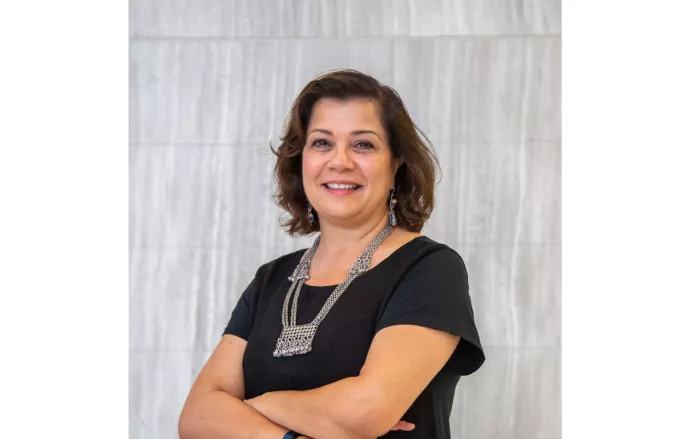
Perspectives on Art
Ruba Kana’an says that growing up in the Middle East was partially responsible for her enduring fascination with the built environment, architecture, and the narratives that come from artefacts.
“Jordan is like an open-air museum because everywhere you turn your face there is a historical monument, dating back from around 7000 BC all the way into the modern period,” says Kana’an on the April 2022 edition of VIEW to the U podcast.
“My particular interest in all of this is that is I like working with objects, I like looking at objects and exploring the stories that tell us about people that emerged out of these objects.”
Kana’an, an assistant professor of Islamic art and architecture in UTM’s Department of Visual Studies, has an extensive research program that focuses on art, artists, and art production, and also considers the formation and meanings of mosque architecture in Muslim societies around the world, which extends from China to Spain and spans several hundreds of years, from the seventh century to present day. She is particularly interested the history of the Friday or congregational mosque, where Muslims usually come together at a main monument in a city or in a neighbourhood for Friday prayer.
“Travellers who are there [in a city] on the Friday went to the mosque and left their impressions and their stories in their traveller’s account, including what they think of the architecture, what they think of the art there,” says Kana’an.
“This documentation is very rewarding to work with from a historical perspective and from an academic perspective, almost as a lens on a society at any specific moment of time, but also in providing a very broad range of how Muslims chose to express themselves architecturally in the different regions. So, a congregational mosque in Mali, for example, looks very different than a congregational mosque in Iran or in Turkey, yet they fulfill the same function, but there's also a way to look at the diversity of artistic expression amongst Muslims throughout the world.”
Kana’an has also explored mosques in North America, and says the oldest mosque in Canada, the Al-Rashid Mosque in Alberta, is an interesting study. Built in the 1930s by Ukrainian-Canadian contractor Mike Drewoth, the mosque resembles a Ukrainian church. She says these mosques often reflect the diversity of diasporic communities and where they came from.
Exploring the stories an object or a building conveys is something she also encourages in her students.
Kana’an has a regular exercise called “Imploding the object” that requires students to look at a particular three-dimensional object she brings to the classroom and consider what questions they might ask about it. She says questions come up regarding its design, including shape, style, and colour, but the considerations expand out from there.
“They ask questions about labour – how it was made? How it is marketed? What does that tell us about society?” says Kana’an.
“They definitely start talking about the environment: what is its impact on the environment? Is it something that has more than one life? Is it something that can be reused? And they start looking at whatever that object is from a perspective of ‘what questions can I ask about this that are relevant from my perspective?’”
Kana’an says this last point is important: it is a particular aim for her to bring students in so they can articulate their critical questions drawing on their own individual and respective worldviews.
This sort of engagement is rooted in Kana’an’s history.
Prior to returning to academia and becoming a full-time faculty member at UTM in 2020, she worked extensively in outreach and scholarly communications, and was an integral member of the leadership team of the Aga Khan Museum three years before it opened in Toronto in 2014. The museum is the only one of its kind dedicated to Islamic art in North America. She says she was fortunate to have the opportunity to shape the stories the museum wants to tell, and that learning to reach a diverse community in her museum experience has helped inform her current teaching and research communication.
“One of my major roles at the Aga Khan Museum was that I was responsible for educational and scholarly programs, which requires communicating about the art to different groups of visitors, whether that is a child, a scholar, or a family coming to the museum for an outing,” says Kana’an.
“It is very interesting to move out a little bit of the scholarly communication that I would have with my colleagues in a conference, or the role of an educator talking to undergraduate students focusing on specific areas that I'm interested for them to learn, into the more sort of public-facing communication about art and education that you only get in a museum experience. But drawing on this experience of public-facing communication about my research, and bringing it into the undergraduate teaching experience where our students also come from very diverse backgrounds, I think about how to make something relevant to the students, so that they can – we hope – enjoy the teaching, engage with it, and see why it's relevant to them.”
Hear the full interview on VIEW to the U podcast. A full transcript of the interview is also available.
